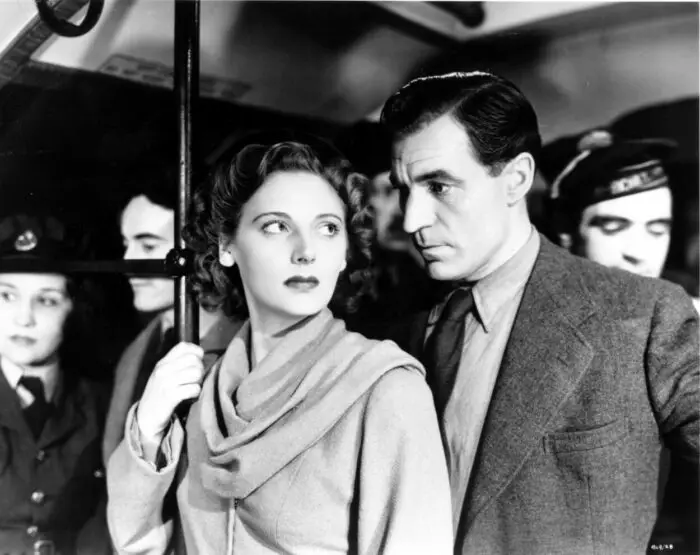Michael Powell, who with his co-director Emeric Pressburger was one-half of England’s greatest directing team, has claimed their 1949 wartime noir thriller The Small Back Room as “my best film.” This from a man who can count among his work The Red Shoes, Black Narcissus, The Life and Death of Colonel Blimp, I Know Where I’m Going!, and others is no small boast. The Small Back Room may be neither the most lauded nor the most notorious of “The Archers'” (as they nicknamed themselves as their production company) efforts, but a new 4K restoration and re-release from Rialto Pictures will surely cause others to reconsider whether it can stand alongside, or even above, their very best films.
The Small Back Room contrasts starkly with the lush Technicolor melodramas for which the Archers were best known. Those films, especially Black Narcissus and The Red Shoes, lavished lurid color on their tortured protagonists, doubling down on their psychological torment with a hyperbolic mise-en-scene and high-stakes cliffhangers (in Black Narcissus, more than a little literally so!). By comparison, The Small Back Room is positively understated, focusing on the everyday functions of the men and women who worked far from the front in support of the British war effort.
It’s the Spring of 1943 and bomb disposal expert Sammy Rice (David Farrar) is consigned to a back office job in the Ministry of Defence. His aching tin foot is probably one reason; his love of drink might well be another. Still, he’s got a girl, Sue (Kathleen Byron, Farrar’s Black Narcissus co-star, here luminous and demure), even though he suspects her love might be based on pity. The “dope” he’s been prescribed does little to assuage his physical pain, and it’s all he can do to lay off the Highland Whisky.

Sammy might be hobbled and he might be on the verge of alcoholism, but he’s still knowledgeable enough to be of use to the cause when the Germans appear be dropping a new antipersonnel bomb on innocent victims and unsuspecting children. He’s assigned to investigate the clever contraption, a trembler-detonated flask-shaped device that begins to preoccupy his thoughts. Worse, he starts to doubt Sue’s love, and his mental and physical state deteriorates. His empty apartment turns into nightmare fuel as he descends into a manic state and a night of terror.
Fortunately for the British armed forces (and humanity in general), Sammy manages to sober back up just long enough to be sent out into the field, where the fiendish devices have claimed more victims, including another disposal expert. He’ll have to muster every ounce of sober, careful expertise to defuse the units—and in doing so, earn back the trust of his superiors, advance the war effort, and like in any good midcentury war drama, win over his girl, once and for all.

The plot, adapted from a novel by Nigel Balchin, isn’t any great shakes, so to speak, and even Pressburger was less than enthusiastic, only agreeing reluctantly to make the film three years after Powell first pitched it. But it offers up its audience an opportunity to celebrate the work of the commoners and labor force in support of the war effort through those who toiled away in “small back rooms” across the country. And while its scope may be less epic, its mise en scene less grand than The Red Shoes or Black Narcissus, the kinds of films for which The Archers had already become known, it nonetheless gave the two directors room to play with the increasingly popular film noir idiom.
The Small Back Room isn’t, technically, a film noir per se. Some ninety percent or so of the film is straightforward wartime romance (and very good wartime romance at that). But to convey Sammy’s anxiety and desolation borne of pain and drink, The Archers employ the chiaroscuro lighting, canted angles, and expressionist staging of film noir as Sammy fights off the delirium tremens in his apartment: framed pictures and pill bottles taunt him and his omnipresent bottle of Highland Whisky grows to gargantuan size.
But only in this scene and in the final climax does The Small Back Room present the kind of heightened milieu of melodrama for which Powell and Pressburger were already known. Elsewhere, the focus is on the relationship between Sammy and Sue, who live across the hall from each other and work together for the same employer. Their roles—wayward hero and devoted gal—may be as cliched as any from the era, but Farrar and Byron imbue their characters with a fragile humanity that makes them tick. Farrar’s Sammy is a man who is expert in his field but with judgment clouded by pain; Byron’s Sue is as devoted to her man as to her country and knows what to do to help them both, even if she too must suffer until the battle is won.
Like so many of their great films, The Small Back Room is quintessentially British, even a full four years after the war still fighting the good fight with a stiff upper lip—and a tin foot. Even if you don’t rank it as Powell did as the best of their work, it sits nicely alongside it, just a little differently from the masterpieces for which The Archers are best known. Newly restored on 4K with excellent detail in both picture and audio, Rialto Pictures’ re-mastering and re-release of The Small Back Room is a collaboration of Martin Scorsese’s The Film Foundation and the BFI National Archive, in association with Studiocanal. Scorsese, a champion of The Archers’ work, and his longtime editor Thelma Schoonmaker, who was married to Powell from 1984 until his death in 1990, served as consultants.
The new restoration will open at New York’s Film Forum and other theaters around the country beginning June 28.



